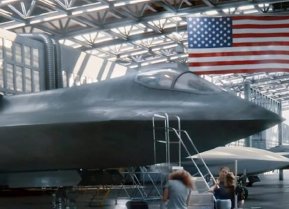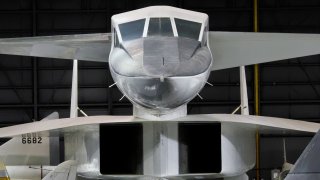XB-70: The Mach 3 Bomber the Air Force Had to Cancel Forever
During the Cold War, the U.S. developed innovative military technologies like the XB-70 Valkyrie, a supersonic nuclear bomber. Despite its advanced design, the XB-70 became obsolete due to Soviet anti-aircraft advancements, notably the S-75 Dvina SAM and MiG-25 Foxbat.
Summary and Key Points: During the Cold War, the U.S. developed innovative military technologies like the XB-70 Valkyrie, a supersonic nuclear bomber. Despite its advanced design, the XB-70 became obsolete due to Soviet anti-aircraft advancements, notably the S-75 Dvina SAM and MiG-25 Foxbat.

-The high costs and emerging Soviet countermeasures led to the program's cancellation.
-This historical lesson underscores the need for the U.S. to adapt quickly in today's multipolar world, where technological competition with China is intense.
Why the U.S. Abandoned the XB-70 Supersonic Bomber
The Cold War was a wild era in the development of military technology, especially in the field of aerospace. From nuclear-powered strategic bombers concepts to Manned Orbital Laboratories (MOL) that would have created a permanent military presence in orbit, some of the craziest—and most innovative—designs were bandied about, all so that the United States could keep ahead of its dreaded Soviet enemy.
Some of these concepts even got off the drawing board. Some of these concepts, like the SR-71 Blackbird, made a significant contribution to the national security of the United States (while breaking just about every flying record imaginable).
One aircraft in particular continues to boggle the mind.
That is the Air Force’s concept for what was basically a high-altitude, supersonic nuclear bomber. Known as the XB-70, this was the Air Force’s attempt to take the heavy payload capacity of the B-52 Stratofortress and marry it to the supersonic capabilities of the B-58 Hustler.
The Ride of the XB-70 Valkyrie…Cut Short
Named the Valkyrie and designed by North American Aviation, a defense contractor back in the mid-twentieth century (that ultimately became part of Boeing through a series of mergers and acquisition), the XB-70 was powered by six General Electric YJ93 turbojet engines. These engines allowed for 28,800 pounds of thrust. There were also powerful afterburners on the XB-70. In fact, those afterburners were the key to prolonged supersonic cruise speed. Thanks to this and other key aerospace design features (like retractable wings and a delta shape), the XB-70 was able to cruise at an astonishing Mach 3.

Because of this capability, Air Force planners believed that they had a nuclear bomber that could outrun and outfly anything that the Soviets possessed.
Sadly, the XB-70 was obsolete before it ever took flight. That’s because the Soviets developed an anti-aircraft weapons system that could destroy even the Mach 3-flying XB-70, making whatever other capabilities the bird possessed worthless. In 1955, when her designers first conceived of her, there was nothing in the Soviets’ arsenal that could counter the capabilities that the Valkyrie was bringing to any potential fight. The Soviets were so scared of what this strategic bomber could do that they dedicated immense resources to developing and deploying countermeasures against her.
The Soviet S-75 Dvina surface-to-air missile (SAM) had been in development for seven years and came online just when the Valkyrie was set to take flight in 1964. It was “more than a match” for matching the XB-70. Not only was the S-75 Dvina SAM system operational by the time the Valkyrie was ready to hit the skies, but so too was the Soviet’s fastest fighter-interceptor to date: the MiG-25 Foxbat. This warplane was specifically designed with the XB-70 in mind. Thus, whatever nuclear bomb capabilities the XB-70 possessed—and whatever threat this system was designed to pose to the Soviet Union—was negated before the Valkyrie even deployed.
That, and the fact that the Valkyrie was a costly plane-per-unit necessitated Washington’s policymakers to rethink its investment in this incredible flying machine. As early as 1961, the Kennedy Administration recognized the risk posed to the Valkyrie was greater than whatever benefits the plane provided.
So, the Kennedy Administration opted to reduce the US government’s commitment to the bird and relegated it to the design phase, drastically cutting its budget and the commitment of the Department of Defense to the Valkyrie program. In 1961, the government had spent $800 million on the program (which is the equivalent of about $7.8 billion in today’s dollars).

It was all waste, as it turned out. The Soviets were, back in the 1950s and 60s, a true peer competitor. Despite whatever one may think about Russia today (and most so-called experts get Russia totally wrong today), it is a mistake to believe that the Soviets of yesteryear were backward or incompetent. They had a strong scientific base and skilled engineers. Toward the end of the Cold War, as the Soviet system was collapsing, that changed. But at the time the XB-70 was in development, the Soviets were keeping pace with their American rivals.
Applications for Today
Today, the United States faces the end of its “unipolar moment” and the birth of a multipolar world in disarray (it is, in fact, a tripolar world divided between the US, Russia, and China). Specifically, the United States is challenged by the rising People’s Republic of China in ways that not even the Soviets at the height of their power challenge America. Integrated into the world trading system, the second-largest economy (in GDP terms), China is not just wealthy but it is a technological dynamo. And in just about every high-tech field—from biotech to quantum computing to aerospace to materials science—China is either on par with the Americans or ahead of them.
In the 2020s, the United States military has spent hundreds of billions building up a high-tech fighting force designed to deter potential foes, like China, from starting a conflict. But, with Beijing’s considerable investment into their own high-tech sector, there is a real (and growing) possibility that China will develop a coterie of next-generation technologies that outstrip key weapons platforms that the Americans rely upon.
Just as the Americans had to abandon their investment into the XB-70 because the Soviets leapfrogged them technologically, the same could happen only at a grander scale if China continues on the long march toward displacing the United States as the sole remaining superpower that Mao had started them on decades ago.
Author Experience and Expertise: Brandon J. Weichert
Brandon J. Weichert, a National Interest national security analyst, is a former Congressional staffer and geopolitical analyst who is a contributor at The Washington Times, the Asia Times, and The-Pipeline. He is the author of Winning Space: How America Remains a Superpower, Biohacked: China’s Race to Control Life, and The Shadow War: Iran’s Quest for Supremacy. His next book, A Disaster of Our Own Making: How the West Lost Ukraine, is due October 22 from Encounter Books. Weichert can be followed via Twitter @WeTheBrandon.
All images are Creative Commons or Shutterstock.
From the Vault
Russia Freaked Out: Why the U.S. Navy 'Unretired' the Iowa-Class Battleships
Battleship vs. Battlecruiser: Iowa-Class vs. Russia's Kirov-Class (Who Wins?)


